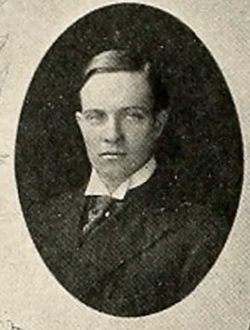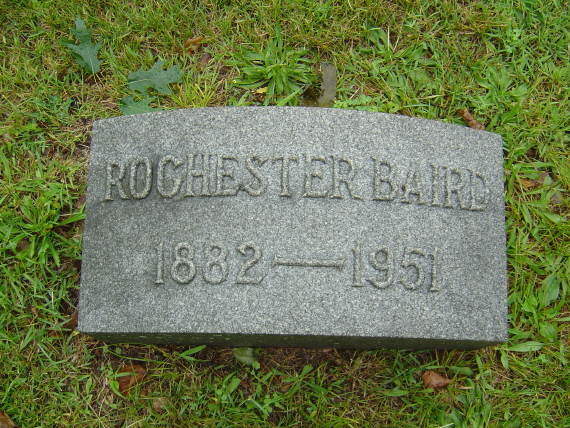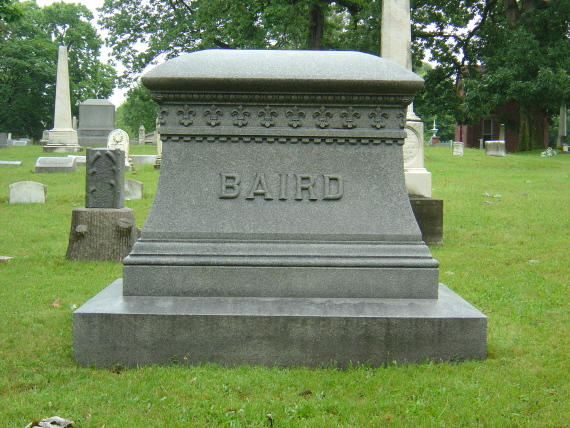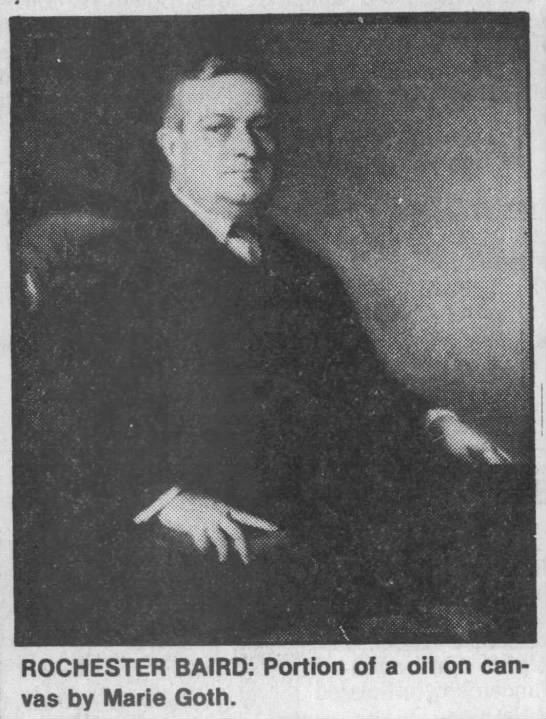The pioneer Baird at La Fayette was Zebulon Baird, who was a native of Monmouth County, New Jersey, and of Scotch ancestry, being a descendant of John Baird, who came to New Jersey in 1683. Rochester Baird is a descendant in the seventh generation from this Colonial American. Zebulon Baird went to Ohio and graduated from Miami University at Oxford. He studied law under the famous Ohio orator and statesman, Tom Corwin, at Lebanon, Ohio. In the spring of 1838 he came to Indiana and settled at La Fayette, and soon afterward became a partner of Judge Ingram, one of the oldest attorneys in the Wabash Valley. Zebulon Baird served with the rank of captain in the Union army during the Civil war and was on the staff of Gen. Robert H. Milroy at the battle of Bull Run, where he was captured and sent to Libby Prison. Zebulon Baird married in Ohio, Martha M. Probasco, member of a prominent family of that state.
Their son, the late Samuel P. Baird, who at the time of his death on October 21, 1925, was recognized as the dean of the Tippecanoe County bar, had a most distinguished career, not only as a lawyer but as a citizen, a scholar, and in his early life was an officer of the United States Navy. He was a native son of La Fayette, born October 16, 1842. He was educated in common and private schools and in 1861 was appointed by President Lincoln a cadet in the United States Naval Academy at Annapolis. He was the first La Fayette boy to receive that honor. He was graduated with honors from the academy in 1865 and became a midshipman. While on a leave of absence from the academy in July, 1863, he joined a home guard company that went to the Ohio River to protect the country against Morgan's raiders, acting as a lieutenant of the company. In 1866 he was ordered for duty aboard the U. S. S. Pensacola, and the following year went to the Pacific waters, where he was promoted to ensign and became officer of the deck on the U. S. S. Resaca. Within a few months he was made navigating officer, and in less than a year its executive officer, and while with the Resaca was promoted in rank to master and then to lieutenant, and as lieutenant commanded the vessel, being the youngest executive officer in the fleet. In July, 1869, he was ordered east, given duty in the Boston Navy Yard, and later was on iron clad duty at Mound City, New Orleans, and Key West. In 1871 he was made instructor in seamanship and mathematics at the Annapolis Naval Academy, this transfer being made on the recommendation of Admiral Worden.
After a year he resigned from the navy, in November, 1872, and returned to LaFayette. This step had been anticipated by him for several years and he had employed all his spare time in studying law. From boyhood he had been under the inspiration of his father, who was famous for his legal learning and to whose leadership he credited much of his success in the profession. After the death of his father in 1877 he was associated in partnership with W. DeWitt Wallace until the latter was elected judge of the Superior Court in 1894. Samuel P. Baird continued practice after that for nearly thirty years, retiring in May, 1923, about two years before his death. In 1898 he tendered his services to the country during the Spanish- American war and received the thanks of the Secretary of Navy.
As lawyer he was devoted whole-heartedly to his profession and neither held nor sought political office. He was regarded as an authority on all phases of court procedure and legal questions and many large interests competed for his service as counsel and adviser. Samuel P. Baird possessed what Bacon called a full mind, and while his knowledge contributed to his success as a lawyer it also contributed to his joy of living and brought him manifold contacts and interests. He had traveled around the world, and his intellectual resources were never limited. In personal character he was irreproachable and his conduct was characterized by rectitude and consideration for the rights of others. His chief recreation was reading and looking after some farm property.
Samuel P. Baird married in 1881 Miss Elizabeth D. Rochester. She passed away May 26, 1903, leaving one child, Rochester Baird.
Rochester Baird was born at La Fayette, September 19, 1882. He attended the grade schools of his native city, went east to the Lawrenceville, New Jersey, preparatory school and in 1906 was graduated from Indiana University. He was admitted to practice in the Supreme Court and the Federal Court, also in 1906, and from that time has enjoyed a steadily increasing business as a lawyer. He was city attorney of La Fayette from 1922 to 1926, and was a member of the legal advisory board during the war. He belongs to the Tippecanoe County, Indiana State and American Bar Associations and is a Democrat in politics.
He married Eleanor M. Ross, a daughter of Mr. and Mrs. David Linn Ross and a member of a pioneer La Fayette family.
INDIANA ONE HUNDRED AND FIFTY YEARS OF AMERICAN DEVELOPMENT Vol. 3
By Charles Roll, A.M.
The Lewis Publishing Company, 1931
The pioneer Baird at La Fayette was Zebulon Baird, who was a native of Monmouth County, New Jersey, and of Scotch ancestry, being a descendant of John Baird, who came to New Jersey in 1683. Rochester Baird is a descendant in the seventh generation from this Colonial American. Zebulon Baird went to Ohio and graduated from Miami University at Oxford. He studied law under the famous Ohio orator and statesman, Tom Corwin, at Lebanon, Ohio. In the spring of 1838 he came to Indiana and settled at La Fayette, and soon afterward became a partner of Judge Ingram, one of the oldest attorneys in the Wabash Valley. Zebulon Baird served with the rank of captain in the Union army during the Civil war and was on the staff of Gen. Robert H. Milroy at the battle of Bull Run, where he was captured and sent to Libby Prison. Zebulon Baird married in Ohio, Martha M. Probasco, member of a prominent family of that state.
Their son, the late Samuel P. Baird, who at the time of his death on October 21, 1925, was recognized as the dean of the Tippecanoe County bar, had a most distinguished career, not only as a lawyer but as a citizen, a scholar, and in his early life was an officer of the United States Navy. He was a native son of La Fayette, born October 16, 1842. He was educated in common and private schools and in 1861 was appointed by President Lincoln a cadet in the United States Naval Academy at Annapolis. He was the first La Fayette boy to receive that honor. He was graduated with honors from the academy in 1865 and became a midshipman. While on a leave of absence from the academy in July, 1863, he joined a home guard company that went to the Ohio River to protect the country against Morgan's raiders, acting as a lieutenant of the company. In 1866 he was ordered for duty aboard the U. S. S. Pensacola, and the following year went to the Pacific waters, where he was promoted to ensign and became officer of the deck on the U. S. S. Resaca. Within a few months he was made navigating officer, and in less than a year its executive officer, and while with the Resaca was promoted in rank to master and then to lieutenant, and as lieutenant commanded the vessel, being the youngest executive officer in the fleet. In July, 1869, he was ordered east, given duty in the Boston Navy Yard, and later was on iron clad duty at Mound City, New Orleans, and Key West. In 1871 he was made instructor in seamanship and mathematics at the Annapolis Naval Academy, this transfer being made on the recommendation of Admiral Worden.
After a year he resigned from the navy, in November, 1872, and returned to LaFayette. This step had been anticipated by him for several years and he had employed all his spare time in studying law. From boyhood he had been under the inspiration of his father, who was famous for his legal learning and to whose leadership he credited much of his success in the profession. After the death of his father in 1877 he was associated in partnership with W. DeWitt Wallace until the latter was elected judge of the Superior Court in 1894. Samuel P. Baird continued practice after that for nearly thirty years, retiring in May, 1923, about two years before his death. In 1898 he tendered his services to the country during the Spanish- American war and received the thanks of the Secretary of Navy.
As lawyer he was devoted whole-heartedly to his profession and neither held nor sought political office. He was regarded as an authority on all phases of court procedure and legal questions and many large interests competed for his service as counsel and adviser. Samuel P. Baird possessed what Bacon called a full mind, and while his knowledge contributed to his success as a lawyer it also contributed to his joy of living and brought him manifold contacts and interests. He had traveled around the world, and his intellectual resources were never limited. In personal character he was irreproachable and his conduct was characterized by rectitude and consideration for the rights of others. His chief recreation was reading and looking after some farm property.
Samuel P. Baird married in 1881 Miss Elizabeth D. Rochester. She passed away May 26, 1903, leaving one child, Rochester Baird.
Rochester Baird was born at La Fayette, September 19, 1882. He attended the grade schools of his native city, went east to the Lawrenceville, New Jersey, preparatory school and in 1906 was graduated from Indiana University. He was admitted to practice in the Supreme Court and the Federal Court, also in 1906, and from that time has enjoyed a steadily increasing business as a lawyer. He was city attorney of La Fayette from 1922 to 1926, and was a member of the legal advisory board during the war. He belongs to the Tippecanoe County, Indiana State and American Bar Associations and is a Democrat in politics.
He married Eleanor M. Ross, a daughter of Mr. and Mrs. David Linn Ross and a member of a pioneer La Fayette family.
INDIANA ONE HUNDRED AND FIFTY YEARS OF AMERICAN DEVELOPMENT Vol. 3
By Charles Roll, A.M.
The Lewis Publishing Company, 1931
Gravesite Details
aged 69
Family Members
Sponsored by Ancestry
Advertisement
Records on Ancestry
Advertisement

















